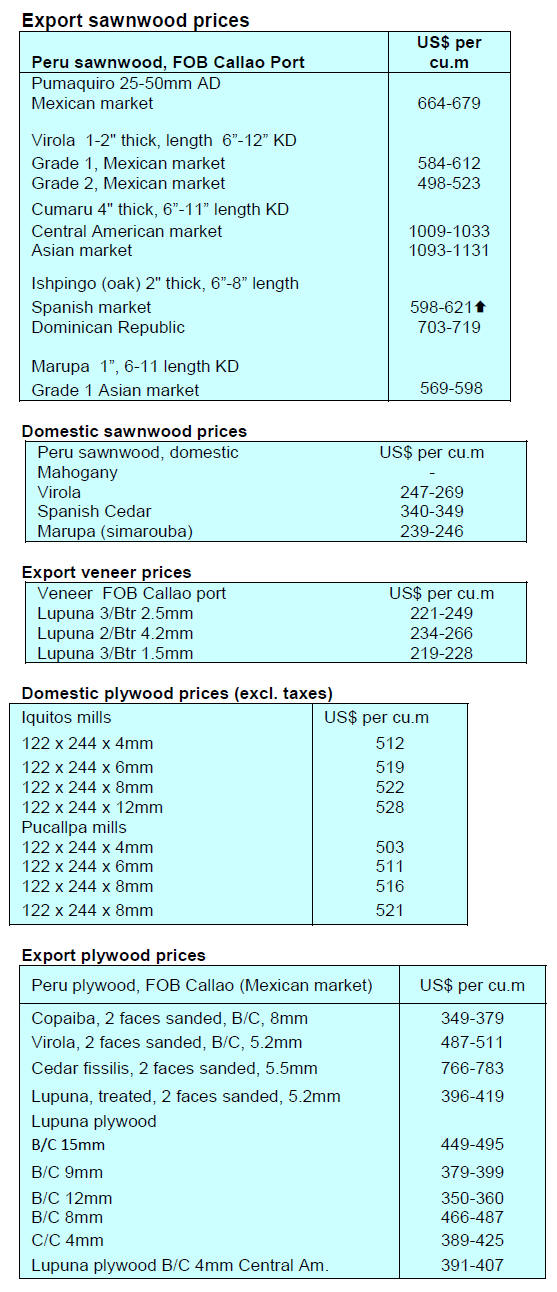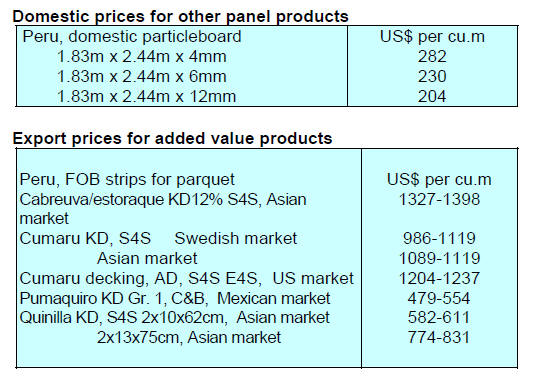4.
INDONESIA
Small enterprises - big contributors
to exports
Indonesia’s exports in August 2021 were valued at
US$21.4 billion, beating the previous all-time high of
US$18.6 billion in August 2011, according to a report in
Antara News. The data coincided with a statement by
Coordinating Minister for Economic Affairs Airlangga
Hartarto supporting small and medium-scale industries
(SMIs—IKM in Bahasa) as major contributors to
Indonesia's positive export performance.
“The positive performance of Indonesia’s exports cannot
be separated from the role of various parties, including the
contribution of IKM players, who were able to survive in
the midst of the COVID-19 pandemic,” said Minister
Hartarto.
The minister said that the contribution of IKMs to
Indonesia’s exports was apparent from the increase in
exports of two commodities based on the IKM sector,
timber and wood products (HS 44) and furniture (HS 94).
HS 44 increased by about 18%, year-on-year, in the period
January–July 2021 and HS 94 grew by 30 percent.
The two commodities were among the top 20 contributors
to Indonesian exports over the period. Exports of HS 44
products were valued at US$2.55 billion over the period,
which was just over 2% of the country’s total exports, and
HS 94 exports amounted to US$1.63 billion, with a share
of 1.4%.
See:
https://en.antaranews.com/news/189469/smis-contributesignificantly-to-indonesias-exports-hartarto
Timber exports still constrained despite SVLK
The Executive Director of the Indonesian Pulp and Paper
Association, Liana Bratasida, has complained that
companies still need to obtain certification under the
Forest Stewardship Council (FSC) or the Programme for
the Endorsement of Forest Certification (PEFC) for
exports to the European Union (EU), despite also having
SVLK certification.
The SVLK is Indonesia’s mandatory national timber
legality assurance system; under the voluntary partnership
agreement (VPA) between the EU and Indonesia signed in
September 2013, the SVLK should be sufficient to enable
trade between the two entities said Ms Bratasida.
Ms Bratasida, quoted in an article by Iim Fathimah
Timorria in Bisnis.com, said that most EU countries do not
carry out the mandate of Article 13 in the VPA, which
holds that the EU has an obligation to promote wood
products in the EU market, including those with SVLK
certification.
The acceptance of SVLK is also a challenge for the export
of wood products and their derivatives to Japan, said Ms
Bratasida, who noted that the Tokyo Metropolitan
Government has implemented a green procurement policy
(GPP), under which paper products that have been
separated from the FSC and PEFC standards cannot be
included in the GPP, even though they have SVLK
certification.
See:
https://ekonomi.bisnis.com/read/20210923/12/1446225/sudahkantongi-svlk-ekspor-kayu-masih-hadapi-kendala-di-negaratujuan
Strengthening the Korea-Indonesia Forest Center
The Minister of Environment and Forestry Siti Nurbaya
said that the function of the Korea-Indonesia Forest Center
(KIFC) needs to be strengthened in line with priority
programmes in the forest sector, according to Antara
News.
Speaking at an online event, “Korea-Indonesia
Cooperation: 10 years of Green Partnership and the Way
Forward”, Minister Siti said that steps have been taken to
align forest governance with various principles, including
improving the quality of the environment as a means to
achieve sustainable development.
See:
https://www.antaranews.com/berita/2396381/menteri-lhkkifc-perlu-diperkuat-untuk-fasilitasi-program-kehutanan
Furniture industry grows in the first quarter
Minister of Industry Agus Gumiwang Kartasasmita, said
the furniture industry grew by 8% in the first quarter of
2021, year-on-year, according to a report in Republika. In
the same period in 2020, the industry shrunk by 7.3% due
to the impact of the COVID-19 pandemic.
“This [growth] means that the furniture and craft industry
has shown to have a high level of resilience during a
pandemic,” said Minister Agus.
The export value of furniture products (HS 9401–9403)
reached US$1.91 billion in 2020, an increase of 7.6% over
2019 (US$1.77 billion), the minister noted.
See:
https://pressrelease.kontan.co.id/release/tumbuh-8-persen-industri-furnitur-tangguh-hadapi-dampak-pandemi
2021 Ifex expected to help restore economy—minister
The Indonesia Furniture Expo (Ifex) Virtual Showroom
2021 will aid Indonesia’s economic recovery from the
impact of the COVID-19 pandemic, according to Trade
Minister Muhammad Lutfi. Indonesian furniture and
handicraft products are among Indonesia’s main export
products.
The export value of the country’s furniture products was
up by 29% in the period January–August 2021, year-onyear,
at US$1.88 billion and the value of Indonesian
handicraft exports rose by 23%, to US$5.8 billion.
Ifex, which is held annually, is one of the largest furniture
exhibitions in Southeast Asia.
See:
https://ekonomi.bisnis.com/read/20210922/12/1445166/mendagsebut-produk-mebel-jadi-salah-satu-andalan-ekspor

5.
MYANMAR
PEFC suspends certification
endorsement process
The Programme for the Endorsement of Forest
Certification (PEFC) has suspended the assessment and
thus endorsement process of the Myanmar Forest
Certification System until further notice. According to a
statement, the PEFC said it had received information
following the launch of its global public consultation
indicating a risk of potential or actual self-censorship or
self-imposed restriction by Myanmar-based stakeholders.
It cited the arrest of one civil-society representative and
pending warrants for officials of the Building
Woodworkers Federation of Myanmar as reasons for the
suspension.
Barber Cho, Secretary of the MFCC confirmed the
suspension. Cho said that it was a severe blow to the
continued efforts of the MFCC to strengthen the SFM
forest certification in the country. However, he
understands the decision by the PEFC was inevitable as
wide and meaningful public consultation must be ensured
for the PEFC endorsement process.
Continuing, Cho said the MFCC will do whatever it can so
the impact of this interruption can be minimised. He said
ongoing activities to strengthen the MFCS will continue so
as to be ready to meet PEFC endorsement requirements.
Cho stressed that safeguarding the forest should be the
priority and certifying forest operations is one of the most
effective ways. He admitted that, even in the past,
inclusive engagement with multistake-holders was most
challenging for MFCC and now the challenges will be
even greater.
See:
https://www.pefc.org/news/pefc-suspends-assessment-ofmyanmar-forest-certification-system
Economic recovery plan to be based on SDGs
The Myanmar Economic Recovery Plan will be based on
the Sustainable Development Goals, according to a report.
The plan, which is not yet public, will reportedly have ten
“action plans”, 27 “expectations” and 407 “action lines”.
Progress towards key performance indicators will be
assessed through a monitoring and evaluation process.
See:
https://www.frontiermyanmar.net/en/regime-seekseconomic-recovery-but-drops-nld-reform-agenda/
UN human rights chief calls for urgent action
Urgent action is needed to prevent the situation
in Myanmar from spiralling into a full-blown conflict, said
the UN High Commissioner for Human Rights Michelle
Bachelet on 23 September. Her warning came in a new
report from the UN Human Rights Office describing the
situation in Myanmar, which is also facing an economy in
freefall and the devastating impact of the COVID-19
pandemic, as “a human rights catastrophe that shows no
signs of abating”.
See:
https://www.ohchr.org/en/newsevents/pages/displaynews.aspx
Four million Covid-19 vaccines arrive in Myanmar
Myanmar received another 4 million doses of China’s
Sinopharm vaccine in September as part of a contract
between the two countries for 24 million doses, of which
3.9 million have been donated by the Government of
China. About 3.47 million people in Myanmar (less than
10% of the total population) had been fully vaccinated
against the COVID-19 virus as of late September, and
another 3.47 million people had received their first doses,
according to Myanmar’s Ministry of Health. Myanmar has
recorded a total of about 461 000 COVID-19 cases since
the beginning of the pandemic, according to the
Worldometers website, and about 17 600 deaths.
See:
https://newsaf.cgtn.com/news/2021-09-27/Another-4-million-doses-of-Chinese-COVID-19-vaccines-arrive-in-Myanmar-13SCm3Tkeqc/index.html
Poverty likely to double
Myanmar’s ongoing political turmoil and a third wave of
COVID-19 cases are severely affecting an already
weakened economy. The economy is expected to contract
by 18% in Myanmar’s 2021 fiscal year (October 2020–
September 2021), with damaging implications for lives,
livelihoods, poverty and future growth.
The share of Myanmar’s population living in poverty is
likely to have more than doubled by the beginning of
2022, compared with levels in 2019. Meanwhile, the value
of the country’s export trade with neighbouring countries
in the period 1 October 2020–3 September 2021 was
US$8.93 billion, down by US$1.3 billion (12.7%), yearon-
year.
See:
https://www.worldbank.org/en/news/pressrelease/2021/07/23/myanmar-economy-expected-to-contract-by-18-percent-in-fy2021-report
6. INDIA
COVID-19
India’s daily count of COVID-19 cases has been declining
since May. There were 31,500 new cases on 23
September, down from the May peak of more than 400
000 daily new cases, according to the Worldometers
website. The country has about 300,000 active cases, and
the official death toll from the virus is 446 000 people.
According to the Ministry of Health and Family Welfare,
more than 841 million people had received the COVID-19
vaccine as of 24 September 2021.
See:https://www.mohfw.gov.in/
and
https://www.hindustantimes.com/india-news/indias-fresh-covid-19-infections-fall-to-26-115-active-cases-at-lowest-in-over-6-months-101632196675605.html
GDP forecast to leap in this financial year
India’s gross domestic product (GDP) is forecast to grow
by 10% in the fiscal year 2021–22, driven by a surge in
domestic demand and exports, according to the Asian
Development Bank (ADB).
The forecast for the 12 months ending 31 March 2022
takes into account disruptions in economic activity caused
by the second wave of the COVID-19 pandemic, which
had adverse impacts on services, domestic consumption
and the urban informal sector, according to an update to
the ADB’s Asian Development Outlook.
The forecast is slightly higher than that of the Reserve
Bank of India, which expects the economy to grow by
9.5% in the current fiscal year. GDP growth is expected to
moderate to 7.5% in 2022–23. The ADB forecast assumes
a relatively limited future economic impact of the
pandemic because of an accelerated vaccination campaign
and better preparedness among businesses, households and
the healthcare sector.
See:
https://www.adb.org/publications/asian-developmentoutlook-2021-update
Container shortage threatens India’s exports
A report by Lakshmi Ajay in Indian Transport & Logistics
News discusses the acute global container shortage, which
is having a profound impact on trade. According to Ajay,
sea freight rates from Cochin to Melbourne was US$650
for a 20 ft container and US$800 for a 40 ft container in
March 2020, before the pandemic hit. Now, these rates
have climbed by 700% for 20 ft containers, to US$5200,
and by 1000% for 40 ft containers, to US$8800.
Similarly, freight rates from Mundra port in Gujarat to
New York was US$1,300 for 20 ft and US$1,600 for 40 ft
containers in March 2020 but have leapt by 592% for 20 ft
containers (to US$9,000) and by 650% for 40 ft containers
(to US$12,000).
According to Ajay, the global shipping crisis is crippling
Indian exporters, who face multiple challenges, from
runaway sea freight rates to transit delays, congestion in
leading ports, an acute shortage of containers, and policy
constraints.
See:
https://www.itln.in/acute-global-container-shortagethreatens-to-derail-indias-export-juggernaut-shipping
Yamunanagar manufacturers raise film-face prices
The trade magazine Plyreporter says manufacturers of
film-faced ply in Yamunanagar, Haryana, have raised
prices for the entire range of shuttering ply by Rp. 1 per sq
ft, effective from 15 September 2021. The decision was
taken at a meeting of film-faced-ply manufacturers chaired
by Devinder Chawla, President of the India Plywood
Manufacturers Association (AIPMA), on 1 September
2021. The AIPMA reported that the Supreme Court has
ruled that the use of formaldehyde is permissible in sealed
units, to the relief of some manufacturers.
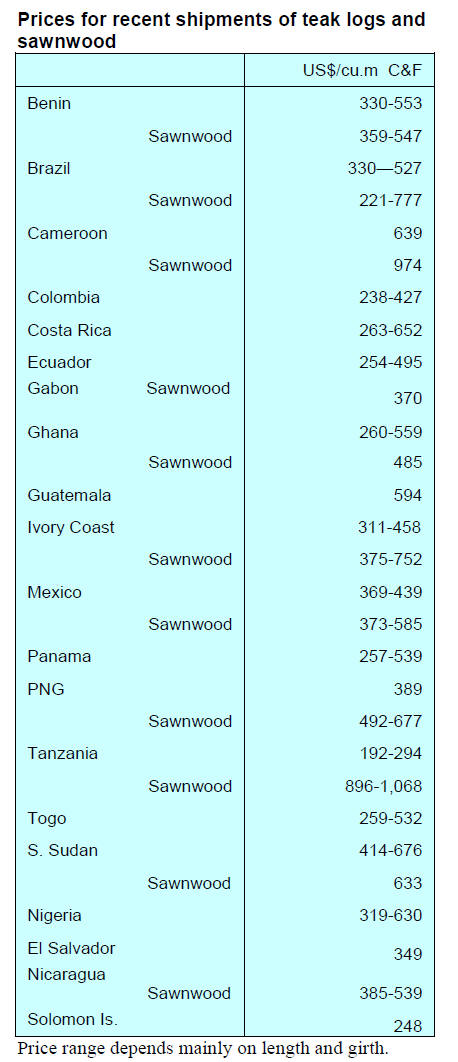

Kandla plywood prices increased
Kandla-based plywood manufacturers have increased
prices by 8% for plywood and by 10% for block boards
and flush doors. A meeting of Kandla-based plywood and
veneer companies discussed recent increases in the price
of imported pine, keruing and face veneer, and other
issues, and proposed the price increase to offset the higher
cost of inputs.
President of the Kandla Timber Association (KTA) Navnit
Gajjar said that the price of imported timber has jumped
because of higher container freight rates.
There is also a shortage of labour caused by state elections
in Assam and West Bengal and the Holi Festival and
harvesting season in Bihar and Uttar Pradesh. The KTA
decided that members should sell finished goods on an
advance payment basis because they are buying their raw
materials on an advance cash basis.
See:
https://www.plyreporter.com/article/92157/breaking-news-kandlabased-plywood-units-increase-prices-from-8-to-10

7.
VIETNAM
Vietnam processors shut down temporarily
Although Vietnam’s wood and wood exports grew by
more than 62% (year-on-year) in the period January–June
2021, they have been curtailed since then by a fourth wave
of the COVID-19 virus, which has disrupted supply
chains.
Many factories have been forced to close due to strict
social distancing, and wood and wood product exports
have fallen sharply. Nevertheless, factories are expected to
operate at reasonable production levels from the end of
September as vaccination rates increase, and trade is
expected to recover.
Vietnam’s wood and wood product exports declined in
September due to disruptions to domestic production.
According to VIFOREST, the target of achieving export
sales of US$14.0 billion in 2021 is now unlikely to be
reached.
The total value of wood and wood product exports was
estimated at US$750 million in September 2021, down by
35% compared with September 2020; of this total, wood
product exports were estimated at US$420 million, down
by 55%, year-on-year. Wood and wood product export
turnover has grown overall by 31% in the year to date
(January–September 2021), to an estimated US$11.1
billion. Wood products accounted for US$8.4 billion of
the total (also up by 30.9%).
Wood and wood product exports were valued at US$177.8
million in the week 14–21 September 2021, up by 2.2%
compared with the previous week. Of the total, sales of
wooden furniture were worth US$98.5 million, up by
5.1% compared with the previous week.
Wood imports in September 2021 were estimated at 505
500 cu.m, valued at US$182 million. This was an increase
of 3.2% in volume and 1.9% in value compared with
August 2021 but a decrease of 2.8% in volume and 18.3%
in value compared with September 2020. In the first nine
months of 2021, accumulated wood imports (logs and
sawnwood) were estimated at 5.15 million cu.m, valued at
US$1.71 billion, up by 21.7% in volume, year-on-year,
and by 33.6% in value.
Log and sawnwood imports into Vietnam accounted for
US$55.2 million in the week 14–21 September 2021,
down by 7.1% compared with the previous week.
The COVID-19 pandemic continues to seriously affect
production and enterprises. Exports of ceramics and
wooden fine arts (wooden handicrafts) decreased sharply
in September 2021, to an estimated US$7 million, down
by 45% compared with August 2021 and by 52%
compared with September 2020. Exports of ceramics and
fine arts were worth an estimated US$163 million in the
first.
Some product groups perform well
Wood products with strong performances in the period
January–August 2021 included wooden seats, at US$2.5
billion (up by 5.1%, year-on-year), guest-room and
kitchen furniture, at US$2.23 billion (up by 40.9%),
bedroom furniture, at US$1.5 billion (up by 29.6%), and
sawnwood and wooden floorings, at US$1.24 billion (up
by 50.2%). Exports of kitchen cabinets and office furniture
grew strongly on the back of increased demand in the
world housing market and the need to furnish offices in
the context of the “new normal”.
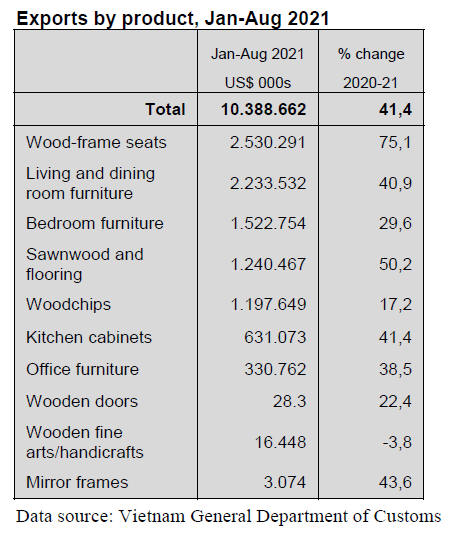
Exports to the US in the period January–August 2021
were
worth US$6.3 billion, a year-on-year increase of 57.2%.
The jump was due to the recovery of the US economy,
along with robust consumer spending there. Vietnamese
exporters have also benefited from US timber legality
assurance and trade fraud control measures in the context
of the US–China trade dispute.
The EU–Vietnam Free Trade Agreement (EVFTA) came
into effect in October 2020, enabling an increase of 27.8%
in Vietnamese wood and wood product exports to the EU
market in the first eight months of 2021.
Vietnamese exports of wood and wood products also
increased to other markets in January–August 2021,
including Japan (+13.7%), China (+23.8%) and the
Republic of Korea (+15.0%).
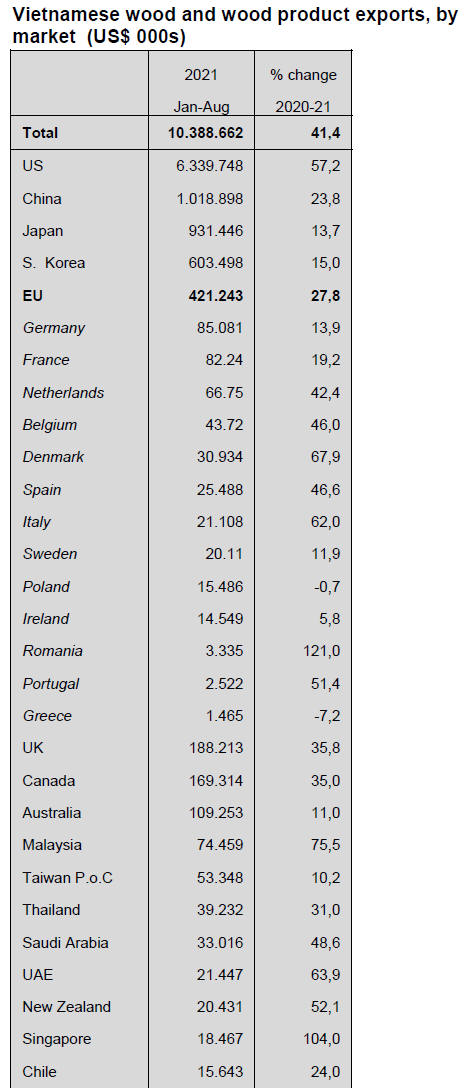
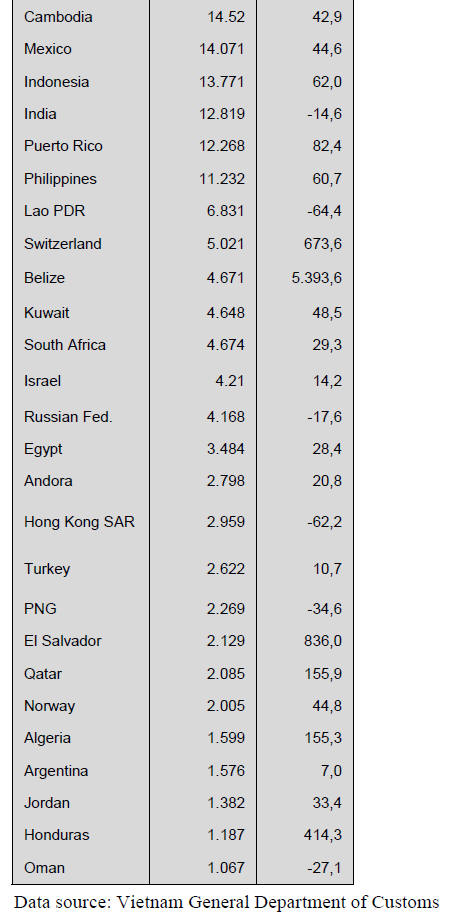
Local plantation resources increase
About 20 000 ha of commercial plantations was
established in Vietnam in August 2021, bringing the total
area of new plantings in January–August 2021 to 143 400
ha, up by 3% compared with the same period last year.
The harvest of commercial logs amounted to 11 million m3
in the same period, up by 5.1%, year-on-year.
The total forest loss in January–August 2021was reported
at 1727 ha, an increase of 45%, year-on-year. This
comprised 963 ha damaged by fire (up by 67%, year-onyear)
and 764 ha lost to illegal cutting (up by 24.6%).
Wood imports
An estimated 505 500 cu.m of wood was imported to
Vietnam in September 2021 at a value of US$182 million,
up by 3.2% in volume and 1.9% in value compared with
the previous month but down by 2.8% in volume, year-onyear,
and by 18.3% in value.
Total wood imports, mainly for use as raw material to feed
Vietnam’s wood processing industry,amounted to about
5.15 million cu.m in the period January–September 2021
at a value of US$1.71 billion, up by 21.7% in volume,
year-on-year, and by 33.6% in 2020.
Pine imports boom
Pine was the most commonly imported species in
January–August 2021, accounting for 21.7% of the total
imported wood volume. Some 1.01 million cu.m was
imported over the period, an increase of 89% in volume,
year-on-year; it was valued at US$235 million, up by
108%.
Oak imports in January–August 2021 amounted to
213 400 cu.m, with a value of US$115 million, a year-onyear
increase of 17.3% in volume and 35.4% in value.
A total of 192 100 cu.m of pachy wood was imported
in
January–August 2021 at a value of US$72 million, up by
4.0% in volume, year-on-year, and by 4.0% in value.
Imports of some other species also increased over the
period, such as eucalypt (up by 73%), padouk (+29%),
beech (+46%), spruce (+42%), rubber (+156%),
mukulungu (+5%) and cedar (+45%).
On the other hand, imports of ash decreased in volume by
14.1% (to 324 000 cu.m) in January–August 2021, yearon-
year, and in value by 8% (to US$75.9 million).
Import volumes declined for some species, including
poplar (-7%), tali (-0.2%), sapele (-30%), walnut
(-16.5%), acacia (-28.0%) and senna siamea (-82%).
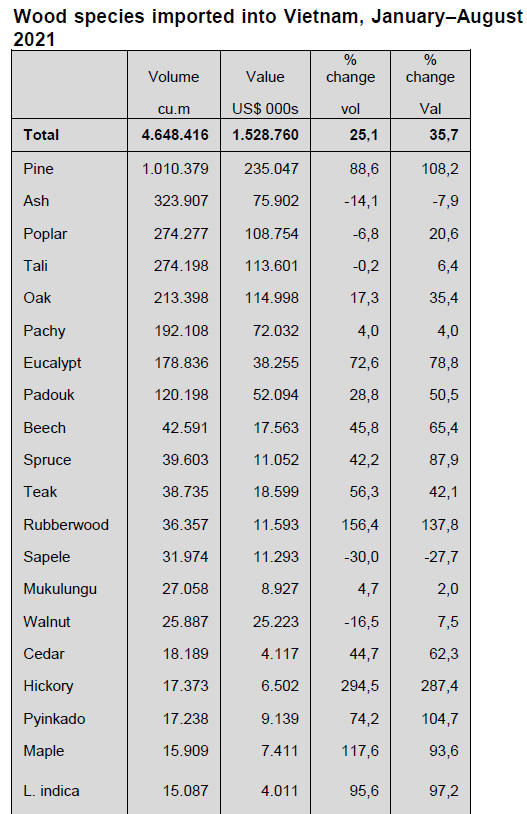

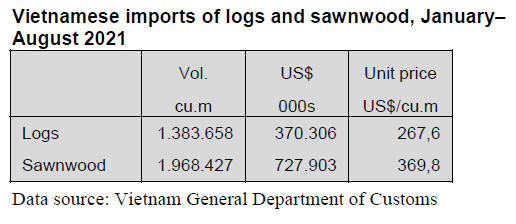
Vietnam increases wood imports from China
Wood imports increased (year-on-year) from China, the
EU, Thailand, Brazil, Chile and Australia in the period
January–June 2021 but decreased from the US, Cambodia,
Papua New Guinea, Malaysia and the Russian Federation.
Imports from China—Vietnam’s biggest source of wood
imports—reached 830 500 cu.m (17.9% of total imports)
and US$322 million in the period, up by 100.5% in
volume and by 91.5% in value, year-on-year.
Imports from the EU—the country’s second-biggest
source of wood imports—in the period from January to
August 2021 amounted to 611 200 cu.m and US$177
million, up by 18.2% in volume (year-on-year) and by
37% in value and accounting for 13.1% of total imports.
Imports were up from the EU countries of Belgium
(+2.5%, year-on-year), France (+21.3%), Germany
(+12.3%), Finland (+55.4%), Croatia (+33.8%), Slovenia
(+75.4%) and Latvia (+216.9%).
Import from Thailand amounted to 378 400 cu.m in the
first eight months of 2021 with a value of US$89.4
million, up by 27.1% in volume and by 55.1% in value
(year-on-year) and accounting for 8.1% of total imports.
Import increased year-on-year in January–August 2021
from Brazil (+146%), Chile (+36.5%), New Zealand
(+10.6%), Uruguay (+90.1%), Lao PDR (81.8%) and
Nigeria (+24.6%).
Imports from the US decreased by 10.2% in volume (to
492 000 m3) and by 14.2% in value (to US$212 million).
Import volumes also decreased from Cambodia (-17.1%),
Papua New Guinea (-32.3%), Malaysia (-11.3%), the
Russian Federation (-39.1%), Suriname (-18.2%) and
Canada (-21.7%).
8. BRAZIL
The economy
The Extended National Consumer Price Index was at
0.87% in August, 0.09 percentage points below the rate in
July (0.96%). The total index value stands at 5.67% for
2021 and at 9.68% for the 12 months to end August. The
average exchange rate ended August 2021 at 5.25 real per
US dollar, down by 1.8% compared with the average in
July (BRL 5.16 per US dollar).
The Central Bank of Brazil adjusted the basic interest rate
by 1.00 percentage points in September 2021, to 6.25%
per year.
Brazilian furniture demand rose in first half 2021
The Brazilian furniture export market grew considerably
in the first half of 2021. The woodworking sector was up
by 14% in the first quarter of 2021, year-on-year. Export
sales for Brazilian furniture grew by 42% in first half of
2021 compared with the previous six months (i.e. July to
December 2020).
The number of orders for Italian machinery and tools for
the manufacture of wooden furniture doubled in the first
half of 2021, year-on-year. Export demand grew by 88%,
year-on-year, and orders in the domestic market leapt by
190%.
These huge increases should be viewed in light of results
in the first half of 2020, which were severely affected by
the COVID-19 pandemic. Nevertheless, the growth trend
is significant—it is more than a simple “recovery”,
constituting a major structural expansion.
See: Móveis de Valor (September 2021)/Jornal Tribuna(August 2021).
Deforestation in the Amazon falls for two consecutive
months
Deforestation in the Amazon totalled 819 km2 in August
2021, according to the National Institute for Space
Research (INPE), down by 32% compared with the same
month in 2020. This was the second consecutive month in
which the deforestation rate fell, year-on-year.
Deforestation was down by 1.2% overall in the period
January–August 2021, year-on-year, at 6026 km2.
Nevertheless, this is still almost double the figure in
January–August 2018.
The Brazilian government has doubled the budget for
environmental control in an effort to reduce the
deforestation rate and plans to hire around 700 new field
inspectors, according to the Ministry of the Environment.
Export update
Total Brazilian exports of wood-based products (except
pulp and paper) increased by 41.4% in August 2021, yearon-
year, to US$413.6 million (compared with US$292.5
million in August 2020).
Pine sawnwood exports grew by 45.3% in value between
August 2020 (US$47.5 million) and August 2021 (US$69
million); on the other hand, they decreased by 7.2% in
volume over the same period, from 275 200 m3 to 255 300
cu.m.
Tropical sawnwood exports fell by 3.3% in volume in
August 2021, year-on-year, to 35 300 cu.m, and by 11.6%
in value, to US$13 million.
Pine plywood exports increased in value by 83% in
August 2021, year-on-year, to US$109.6 million, but
decreased in volume by 17.3%, to 195 900 cu.m.
Tropical plywood exports increased in volume by 55.9%
in August 2021, year-on-year, to 9200 cu.m, at a value of
US$5.6 million.
Wooden furniture exports increased in value by 26% in
August 2021, year-on-year, to US$66.4 million.
Acre ends August with positive trade balance
Acre, a Brazilian state in the Amazon and one of the
region’s largest tropical timber exporters, ended August
2021 with a trade surplus of US$2.5 million. Its main
export product, timber and timber derivatives represented
36% of total exports, at US$2.7 million in August.
The state had a record trade surplus of US$32.9 million in
the first six months of 2021, which was 49% higher than
in the same period in 2020 (US$22.2 million), according
to the Ministry of Economy.
Privatisation of Port of Santos
Brazil’s Ministry of Infrastructure has indicated that it is
making progress in structuring the privatisation of the Port
of Santos in the country’s southeast, with a view to
presenting it to a public hearing in October 2021.
The creation of a public–private partnership in the port is
expected to raise BRL 16 billion and transform the port
into the largest terminal in the Southern Hemisphere.
Investments will be made to improve access to the port,
including by increasing the depth of the channel, thereby
significantly improving the country’s export infrastructure.
The Port of Santos is Brazil’s most important port and one
of the busiest in Latin America. Around two-thirds of
Brazil’s rail network supplies the port, which has terminals
for the outflow of specific products, including products of
forest origin.
Source: Agência Brasil (September 2021)
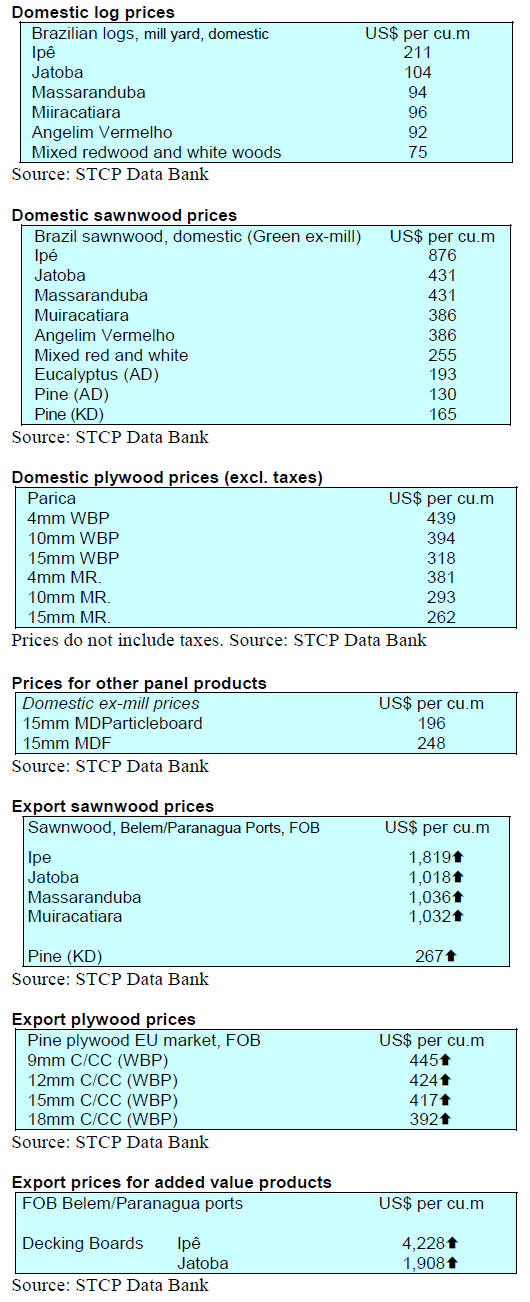
9. PERU
SERFOR and regional authorities
develop control
systems to verify timber legality
The regional forest authorities of Loreto, Madre de Dios,
San Martín and Ucayali, in coordination with the National
Forest and Wildlife Service (SERFOR), held technical
meetings recently to finalise a forest administration and
accreditation system for ensuring the legal origin of the
wood.
The meetings enabled completion of the Control Module
of the National Forest and Wildlife Information System
(MC-SNIFFS), with the system expected to be up and
running in 2022.
The MC-SNIFFS is a joint undertaking between the
regional authorities and SERFOR, with international
technical assistance. The aim is to increase the efficiency
and veracity of the public and private administration of
timber supply chains in Peru, from the forest through
harvesting, transportation, processing and marketing.
MC-SNIFFS will manage information on forest
concessions and forest-use permits, among other things,
and also integrate forest management planning and
management information with data generated in
transportation and processing.
OSINFOR approves new regulation for the supervision
of forest resources
The Forest Resources and Wildlife Supervision Agency
(OSINFOR) approved a new regulation for the supervision
of forest resources and wildlife after subjecting it to public
debate and obtaining views from the public and forestsector
stakeholders.
The regulation, which will come into force on 15 October,
updates a previous regulation, taking into account
regulatory changes to the administrative inspection and
supervision process.
Support for forest restoration in fire-affected areas in
Cusco
The aim of a multisectoral agreement signed between the
Ministry of Agrarian Development and Irrigation
(MIDAGRI), the Ministry of Environment and the
municipalities of Andahuaylillas and Lucre is to restore
areas affected by forest fires in the Cusco region. The
agreement, which spans three years, will help ensure a
coherent and coordinated restoration programme in the
two municipalities.
Minister Víctor Maita said MIDAGRI will provide
technical assistance for the identification and diagnosis of
fire-affected areas and their ecological restoration and
supply seeds of forest species for nurseries to be used in
the restoration effort.
rts imprPeruvian expooved in July
Peruvian exports of all products totalled US$4.2 billion in
July 2021, an increase of 16% compared with the same
month in 2020, according to the Lima Chamber of
Commerce (CCL).
Despite the growth, however, the CCL said there had been
a drop in shipments to some main destination markets.
Exports in July to China amounted to US$1.24 billion,
down by 5.5%, year-on-year, and exports to the US were
valued at US$564 million, a drop of 12.7%. Exports also
declined to Canada and Japan. On the other hand, exports
leapt in July to India, the Republic of Korea, Switzerland,
the Netherlands, Brazil and Chile.
